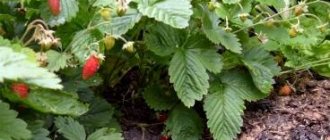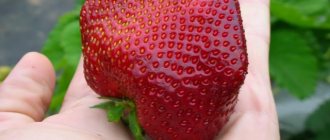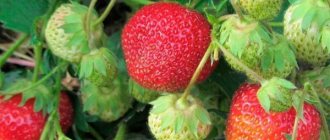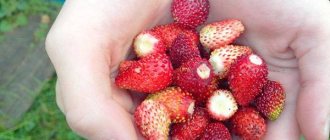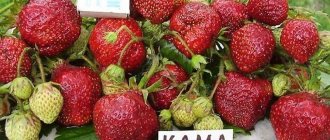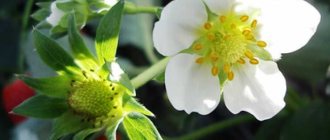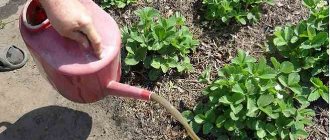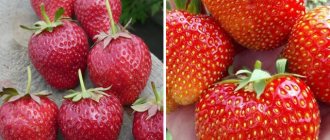History of the variety's creation
Strawberry Elvira was bred by Dutch specialists, but official sources do not contain information about the specific breeders or agricultural companies that were the originators of this variety. Also, this variety is not included in the lists on the official websites of Dutch nurseries and manufacturers, so there are no offers for the sale of seedlings or any other official information.
Interesting!
Strawberry varieties for the Moscow region are the most delicious.
Apparently, the Elvira strawberry did not sufficiently meet the expectations of gardeners, and they preferred to purchase more successful new varieties of garden strawberries and strawberries.
The Elvira strawberry is also not included in the Russian state register. However, since about 2010, its microclonal samples have been stored in the cryocollection of the Institute of Plant Physiology named after K. A. Timiryazev.
Garden strawberry Elvira. Brief overview, description of characteristics - video
How to care for garden strawberries
Caring for garden strawberries is quite simple, especially for such unpretentious ones as Elvira. The basis of care is timely watering and fertilizing.
Watering
Water it with warm, settled water. Irrigate the bushes at the root, early in the morning or in the evening, when the sun is below the horizon. It is strictly forbidden to use water from a well. Cold water can promote the development of fungal diseases.
Water it once every 7-8 days. If the temperature is very high, then the number of waterings is increased to two or three per week.
Many agronomists advise carrying out the loosening procedure after watering. It will not only saturate the strawberry root system with oxygen, but will also get rid of parasites hiding in the soil and weeds.
In addition to loosening, it is necessary to periodically remove the formed mustache.
Feeding
In general, during the entire growing season, strawberries need 3-4 feedings. They are harmoniously combined with irrigation. Standard feeding scheme for this strawberry:
- Garden strawberries are fed for the first time in early spring, immediately after the frosts have ended. At this time, the plant needs nitrogen-containing fertilizers, which stimulate the growth of its green part.
- The second time garden strawberries are fertilized after flowering, when the berries begin to form. This time the strawberries are fertilized with phosphorus-potassium fertilizers.
- The last time it is fertilized is in the fall, after the end of the growing season. This time it is fertilized with organic matter. It will saturate the plant with the necessary microelements and allow it to survive the winter painlessly.
Strawberry Elvira: variety description
This strawberry variety is classified as non-remontant,
therefore, the bushes are harvested only once, but fruiting is extended over time for about 20-25 days - the fruits on each peduncle ripen gradually. You can see on one bush simultaneously blossoming buds, emerging ovaries, ripening and ripe berries.
Therefore, in the period from early May to mid-late June, Elvira strawberry bushes have an attractive decorative appearance.
The variety is recommended to be grown in open ground in the Moscow region and other regions with similar climatic conditions
. And in more northern regions it is better to plant these strawberries in film greenhouses or greenhouses.
Photo of strawberries Elvira
Strawberry Elvira is one of the earliest varieties of this berry crop. Moreover, many gardeners accelerate the ripening period of Elvira fruits by growing it in greenhouse conditions and film greenhouses.
You can grow Elvira even at home on window sills or glassed-in loggias as hanging plants in special pots or hanging flowerpots.
The bushes are of medium height, with a large number of leaves located on high petioles. The foliage is medium in size, with large jagged edges, slightly wrinkled, rich emerald color.
EXCELLENT VARIETIES OF STRAWBERRY!
Strawberry Alba Strawberry Asia Strawberry Borovitskaya
Note!
Under favorable weather conditions, the Elvira strawberry variety begins to bloom in early May.
Due to the fact that the peduncles are low and located below the leaves or at their level, the flowers are practically not susceptible to the effects of returning spring frosts. Also, the buds are not afraid of periods of prolonged rain.
The flowers are large in size, with white petals and well-developed stamens. Male and female flowers appear simultaneously on the same peduncle.
Just one Elvira strawberry bush can produce up to 10 flower stalks per season, on which up to 100 berries ripen.
In one place, this strawberry variety can grow for at least 4 years, but with good care, Elvira’s strawberry plantation can grow up to 8-10 years.
The resistance of Elvira strawberry bushes to frost is at an average level.
Review of early varieties Syria and Elvira
Suitable region and climate
Despite the fact that, judging by the reviews of gardeners, the geography of distribution of the variety is quite wide, Elvira is not included in the State Register of Russia. It is not in the State Registers of other countries of the former Soviet Union.
The climatic conditions of central Russia, including the Moscow region, are best suited for growing Elvira. But even in the southern regions, Elvira has proven itself well on plantations with drip irrigation. And in protected soil conditions it is successfully grown even in the northern regions.
Main characteristics
Strawberries Elvira are large-fruited, the shape of its berries is conical with blunt tips. The fruits have a characteristic gloss, orange-red color, their weight ranges from 25 to 50 g. The first collected berries usually have a maximum weight of 50-60 g.
The achenes are small, yellow or red, pressed into dense pulp, which is juicy and has a pleasant sour-sweet taste.
On a note!
Tasting assessment of the taste of Elvira strawberry fruits - 4.4 points out of 5 possible.
Ripe fruits tolerate transportation well over different distances and can be stored in a cool place for up to several days.
The harvested crop is distinguished by its versatility - Elvira’s fruits can be eaten fresh, prepared in desserts, preparations, and also stored in the freezer for the winter. Many gardeners make homemade delicious aromatic liqueur from the harvested crop.
Features of care
Despite its unpretentiousness, Elvira strawberries cannot do without human hands. Maintenance measures are standard: watering and loosening, weeding and fertilizing, disease prevention and pest control. Although some nuances need to be taken into account
Watering and loosening
Water the strawberries with warm water at the roots, being careful not to wet the foliage, especially after throwing out the inflorescences. When the water is absorbed, the soil must be loosened. The depth should not be more than 8 cm, otherwise the roots may be damaged.
Attention! Loosening is vital for Elvira strawberries to saturate the root system with oxygen. This procedure also protects the roots from fungal diseases and rot.
During loosening, weeds are simultaneously removed. It’s no secret that disease spores and pests like to settle on them. Weeds must be pulled out by the roots.
On bushes intended for fruiting, the mustache must be removed during the growing season.
Top dressing
The strawberry variety Elvira, according to the description and reviews of gardeners, responds well to timely fertilizing, which is combined with watering.
You can use mineral or organic fertilizers. From organic matter, an infusion of chicken manure, mullein and green grass is often used. But for the proper development of strawberries, you need to adhere to a certain scheme:
- In early spring, you need to feed the plantings with nitrogen fertilizers or ammonia. Nitrogen is necessary for the growth of green mass.
- At the moment of throwing out the flower stalks and filling the berries, the Elvira strawberry feels the need for phosphorus and potassium.
- The last fertilizing also consists of phosphorus-containing fertilizers; it is carried out after harvesting before preparing the plants for wintering.
Experienced gardeners recommend watering strawberries of any variety with an infusion of wood ash and dusting the plantings with dry matter.
In harsh soil conditions, beds with strawberries of the Elvira variety are covered. Before this, the leaves are cut off and sprayed with pest control compounds. Cover it with non-woven material, and throw a layer of earth on top.
Productivity
Thanks to the large number of flower stalks, each of which produces up to 10 berries per season, the yield of the Elvira strawberry variety is quite high - up to 1.5-2 kg of ripe fruits can be collected from each bush
. This result is achieved under favorable weather conditions and good care, including regular watering and fertilizing.
In Russian regions, gardeners growing this variety talk about 700-800 g of berries collected from each bush.
Diseases and pests
According to Dutch breeders, the variety:
- Susceptible to powdery mildew.
- Moderately sensitive to root rot, fruit rot and verticillium wilt.
- Resistant to anthracnose.
Elvira is resistant to brown spot that affects foliage, strawberry mite, gray fruit rot, verticillium wilt and anthracnose. The culture's immunity is slightly weaker relative to late blight (red) root rot. Poor immunity to powdery mildew. If the berries are not susceptible to pest attack, they can be damaged by wasps and birds, so you need to take care to protect the garden bed.
We suggest you read: How to distinguish a rat from a mouse
Did you know? There are varieties of strawberries that are white with red seeds. Their berries taste similar to pineapple.
“Glyokladin”, “Trichodermin”, “Trichotsin”, and for powdery mildew - “Baktofit”, “Alinin B”. The products are diluted and used according to the instructions indicated on the drug packaging.
To prevent most diseases, it is sufficient to treat the crop with iodine solution (10 ml/10 l of water) once every 1.5 weeks, starting in May.
Pros and cons
The main advantages of Elvira strawberries include:
- early fruit ripening;
- bushes of this variety grow on almost any soil and tolerate the rainy season and periods of drought;
- fruiting is extended over time, many gardeners say that Elvira strawberries can be harvested from the beginning of June to the end of August;
- the harvested crop tolerates transportation well at different distances and is well stored in appropriate conditions;
- frost resistance - Elvira bushes withstand frosts down to -20 degrees Celsius;
- plants are practically not damaged by fungal diseases and do not suffer from attacks by “harmful” bugs.
There are no serious deficiencies noted in this variety. But you need to remember that when caring for a strawberry plantation, you must often loosen the root zone of the bushes.
The berries are collected continuously throughout the entire fruiting period, and bushes of this variety must be covered before the onset of winter if frosts below -20 degrees are expected.
Subsequent care of the crop
To obtain a good yield, it is recommended to apply fertilizer throughout the season. The procedure for applying fertilizing is as follows:
- before planting, add a small amount of humus, compost or wood ash under the hole;
- 1-2 weeks after planting, nitrogen fertilizers are applied, which increases the growth of green mass;
- During the flowering period and fruit formation, strawberries need phosphorus and potassium.
Despite the fact that the crop is considered unpretentious, it needs irrigation and loosening. Watering is carried out at the root, after which it is necessary to loosen the soil to a depth of 10 cm.
To ensure that plants retain moisture for a long time, the soil is mulched. In addition, the growth of weeds will be prevented, and in winter, a layer of mulch will prevent the plantings from freezing out.
Preparing for winter
Despite the fact that garden strawberries can withstand low temperatures down to -20 °C, it is recommended to cover the crop for the winter. In the case when a small amount of snow falls in a particular region, and the frosts are quite severe, it is worth using spruce branches and straw as shelter.
Before sending the Elvira variety strawberries for the winter, you must first apply fertilizing. For these purposes, fertilizers containing phosphorus are used.
Strawberry propagation Elvira
In one area, strawberries of this variety grow up to 4 seasons, and then its fruits begin to become smaller, as a result, the yield sharply decreases. Therefore, after this period, it is recommended to move Elvira’s strawberry plantation to another site.
This Dutch strawberry variety can be propagated in the following ways:
- seed material;
- mustache;
- dividing mother bushes.
Growing Elvira strawberries from seeds
Most gardeners prefer not to propagate strawberries by seeds, since the process of growing this berry crop from seed material is quite labor-intensive and not always rewarding. The fact is that the germination rate of strawberry seeds is quite low, and the seedlings obtained in this way are not stored for long, so they must be planted in a permanent place as soon as possible.
Need to know!
The reason for the non-germination of seeds is not always their low quality. Gardeners often violate the technology of growing strawberry seedlings from seeds, resulting in either not receiving seedlings at all, or they will be weak.
It is better to purchase Elvira strawberry seed material from trusted sellers - in nurseries, or from well-known agricultural companies that distribute seeds of vegetable and horticultural crops.
Dividing mother bushes
Elvira strawberries are propagated in this way in early spring, until the plants' buds have fully awakened. Dig up healthy strawberry bushes and divide them into several sections, each of which should contain one healthy heart and at least 4-5 roots. Each division is planted in a pre-prepared planting hole.
Propagation of Elvira strawberry with a mustache
To obtain high-quality planting material, you should properly grow the bushes from which rosettes will be selected in the future.
In the mother bushes from which the tendrils will be collected for replanting, it is necessary to remove the flower stalks in a timely manner so that the plants devote all their energy and nutrients to the formation of rosettes. Such strawberry bushes should be strong and healthy, without visible damage or signs of disease.
For further planting, only those Elvira strawberry rosettes that are located first from the mother bush are selected.
Harvest and storage
The ripening of berries begins in the last month of spring and continues through the first month of summer. Harvesting is carried out as the fruits ripen. The harvest can be stored for quite a long time in the refrigerator. To do this, you do not need to wash it, but simply put it in a plastic container for vegetables. You can freeze the berries.
The Dutch variety Elvira is quite a worthy crop to take a place on your plot. It is easy to care for, it is not very demanding in agricultural technology, and if all care rules are followed, it pleases with an excellent harvest. The fruits are universal, so they can be used for any purpose.
Agrotechnics of cultivation
This variety of strawberries is distinguished by its unpretentiousness to the place of growth, as well as sufficient resistance to fungal diseases and root rot. Therefore, Elvira can be planted both in open sunlit areas and in light partial shade of shrubs and fruit trees. This variety also tolerates excessive soil moisture.
Growing strawberries. 7 important growing mistakes - video
Selecting a site for planting
It should be remembered that this strawberry produces high yields only on fertile soils, therefore, before planting the Elvira variety, organic matter and mineral fertilizers must be added to the prepared beds for digging.
If all the necessary fertilizers were added to the soil before planting, then in the first season it does not need to be fertilized.
Planting planting material
Elvira strawberries can be planted throughout the summer season. In the beds it is planted in a strip method in one or two rows. With this method of planting, strawberry bushes will be easier to care for in the future.
You can plant rosettes not only on ordinary beds, but also under black material in which holes are made for strawberry bushes.
In greenhouse conditions, the scheme for planting seedlings is 0.25 * 0.3 m. In the garden, it is better to plant plants at a distance of 0.3 m from each other. The distance between rows must be at least 0.4 m.
Water is first added to the planting holes. When it is absorbed, sockets are installed in the center of the holes and the roots are carefully straightened along the diameter of the hole.
Then the hole is filled with soil, making sure that the heart is located a couple of centimeters above the soil level.
The soil should be carefully compacted and at least 5 liters of water should be added under each plant.
It is better to plant Elvira strawberries in the evening or on a cloudy day so that the plants take root better.
After watering, it is better to mulch the beds with any organic matter to prevent the rapid evaporation of moisture.
Reviews from gardeners
Anastasia Vladimirovna, Rostov, 51 years old.
I really like the variety. I would call it one of the best NSD varieties from Holland. The berries have an oblong shape, the flesh is dense, but for example, unlike Albion, not wooden. The taste is good, the aroma is quite pronounced. It gets sick very rarely, even without any preventive treatments. I grew it in containers, no problems, it grows well.
Nikolai Andreevich, Kyiv, 53 years old.
The strawberries are pretty good. Early ripening. The bush is quite compact, medium-sized. A small amount of whiskers is formed, but it is enough for reproduction. The yield is excellent. The berries are marketable and quickly sold out on the market. The taste is excellent. The berry is sweet and has a rather pleasant aroma. We have been growing Elvira on our plot for more than 5 years, the variety is excellent. Grows normally in damp areas and shade. There are of course some disadvantages. Elvira has a weak superficial root system, so in winter the bushes may freeze if the temperature is very low. It does not tolerate heat well, so in summer, during drought, it needs to be watered regularly.
Strawberry Elvira: reviews from those who planted
Vika, 45 years old, Perm region: Elvira strawberries are one of the few varieties that can be successfully grown in our region. Its fruits ripen early, which is very beneficial for our climate with a short and cool summer season. The fruiting of Elvira strawberries is stable and good despite the weather conditions. The berries are large in size and have good taste. The harvested crop is enough for both food and spinning.
Margo, 35 years old, Bryansk: I accidentally bought seedlings of this variety several years ago. I didn’t think that Elvira strawberries would be so unpretentious and productive. In a couple of years, I have already planted several Elvira beds from my own planting material. Now I grow this variety mainly for sale, since the berries ripen early, when other varieties are just beginning to bloom. As a result, my strawberries are sorted out almost instantly. I recommend to all.
Strawberry Elvira is one of the best early varieties, unfortunately, undeservedly forgotten in Holland.
Its berries ripen in early June and are large in size and have good taste. The fruits have a universal purpose; jam made from the berries of this variety is especially tasty and aromatic.
Advantages and disadvantages of the variety
Why do they love Elvira strawberries and what are the advantages of this variety:
- First of all, this is productivity. Under the most favorable conditions, more than a kilogram of berries can be collected from one bush per season. Typically, the average harvest is from 600 to 900 grams.
- An important characteristic for growing in Russia is frost resistance. Garden strawberries of this variety can overwinter down to a temperature of -20, and with additional shelter they can withstand even more severe frosts.
- Resistance to fungal diseases. Any summer resident who has garden strawberries on his property has encountered gray rot on the fruits or brown spots on the leaves. These are manifestations of fungal diseases that infect plants and destroy crops. Strawberry Elvira is resistant to fungal diseases, and this applies to all parts of the plant - berries, leaves, roots.
- Early maturation. The berries turn red already at the end of May - beginning of June when grown in open ground, and if the bushes are planted in greenhouses, the harvest can be obtained even earlier.
- Length of the harvest season. The fruits do not all ripen at the same time, but one at a time, which allows you to enjoy freshly picked berries for as long as possible.
- Versatility. The variety is suitable for both amateur gardeners for cultivation on their own plots, and farmers for production for sale on an industrial scale. Plants are grown both in open ground and in greenhouses.
- Storage and transportation. Thanks to the non-loose pulp without voids and dense skin, the berry is well stored and can withstand transportation, which makes it suitable for growing for commercial purposes.
- Usage. The fruits of this variety can be eaten fresh, frozen, used as a filling for pies and a base for desserts. The berries are suitable for making preserves, marmalade, marmalade, compotes, fruit drinks and even liqueurs.
- Shade tolerance. Bushes can and should be planted in shaded areas. Direct sunlight is even harmful to the plant.
How to plant
Let's take a closer look at the features of planting Elvira strawberries.
Plot
In general, the variety is not particularly demanding on the site. As mentioned above, Elvira is resistant to root rot and fungus, so it can be grown even in damp and shaded areas. However, it is necessary to place the beds on fertile soil, as this can significantly increase the crop yield.
It is advisable to choose a partially shaded area for Elvira, since constant “attention” to direct sunlight in this case is destructive.
Time
It is recommended to plant strawberries in open ground either in spring or autumn. In this case, the beds for planting can be prepared throughout the summer by fertilizing them and digging them up.
Selection of seedlings
When choosing suitable bushes for seedlings, focus first on those that are located closer to the mother bush: they will produce healthy and strong adult plants that can produce a bountiful harvest.
When choosing seedlings, also pay special attention to the integrity of the foliage. It is important that the leaves are not chewed by pests and do not have diseases. Please note that defective, damaged and weak bushes are unlikely to produce a good harvest, so it is better to discard such specimens at the initial stage.
It will also be useful to learn how to plant strawberry seeds at home.
But this information will help you understand how to grow remontant strawberries from seeds and how to care for this variety of berries
It’s worth learning more about how strawberries are fertilized with yeast in the spring: //gidfermer.com/sadovodstvo/udobreniya-i-podkormki/klubniki-drozhzhami.html
You may also be interested in learning how to get a good harvest of strawberries at your dacha.
Boarding procedure
Elvira strawberries are planted according to the standard scheme. This scheme provides for placing the bushes at a distance of 30 cm from each other, and for row spacing, a distance of 30 cm is also maintained. If you plan to grow strawberries in a greenhouse, then the planting scheme will be 25x30 cm.
The bushes are usually placed in a checkerboard pattern, but if the bed is located in a lowland, or on overly moist soil, it is recommended to plant strawberries in a single line method, as this can prevent the development of gray rot.
In the video - planting strawberries:
When placing the seedling in the hole, carefully but gently straighten its roots. It is necessary that by the time of planting the soil is already well warmed up and moistened. Immediately before planting, thoroughly water the soil so that the strawberries are practically submerged in the soil slurry. This way the roots of the plant will lie as naturally as possible. But here's how to grow strawberries in a greenhouse all year round, and what are the features of cultivation. This is explained in detail in the article at the link.
When planting, make sure that the central growing point of the bush is level with the soil surface.
Top dressing
A plant such as the Elvira strawberry, described in this article, is quite responsive to the timely application of fertilizers to the soil. In order for nutrients to fully contribute to the proper development of the bushes, fertilizing is carried out exclusively during watering. This crop accepts both organic and mineral fertilizers almost equally well. As for the latter, she prefers phosphorus, nitrogen and potassium, and from organic matter - mullein, herbal infusions and bird droppings.
It should be remembered that during flowering, formation and ripening of fruits, in no case should you feed the plant with nitrogenous compounds, because they are mainly aimed at actively increasing green mass. However, in early spring such fertilizers will be simply irreplaceable. The frequency of fertilizing looks like this: the first time fertilizer is applied over the next two weeks after planting the bushes, the second time during flowering, and the third time at the very beginning of fruiting.


